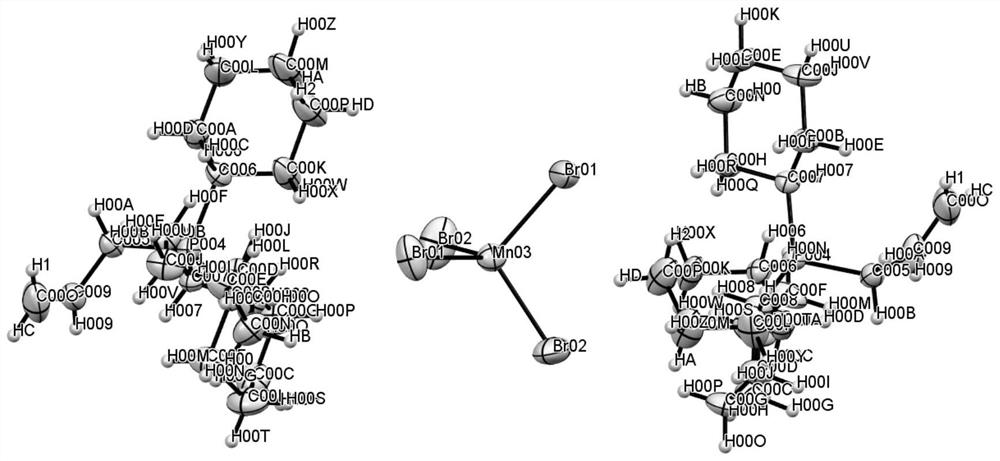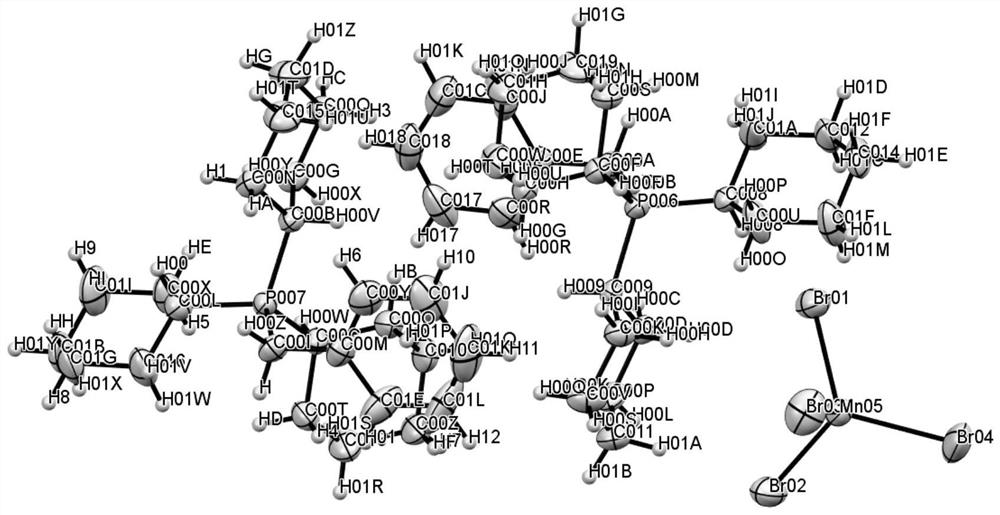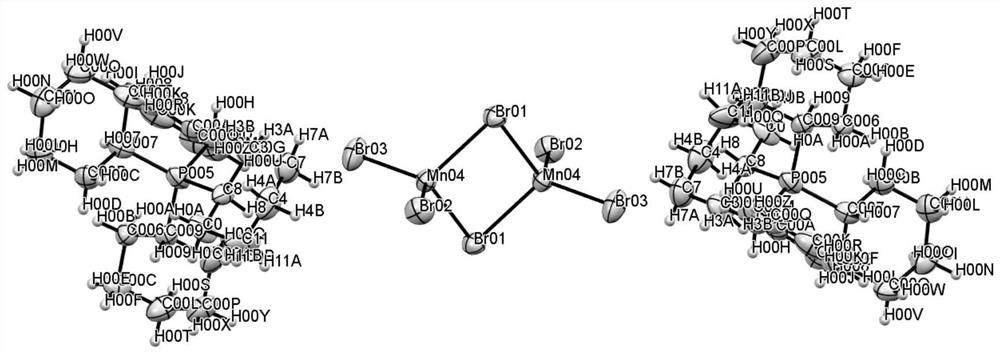Manganese (II) complex based on tricyclohexylphosphine structure as well as synthesis method and application thereof
A technology of tricyclohexylphosphine and a synthesis method, which is applied in the application field of scintillators in radiation imaging and detection, can solve the problems of innovative structures and immature explanations of luminescent material systems, and achieves good responsiveness and broad application prospects. , the effect of low cost
- Summary
- Abstract
- Description
- Claims
- Application Information
AI Technical Summary
Problems solved by technology
Method used
Image
Examples
Embodiment 1
[0049] Example 1: Synthesis of Structure 1 Manganese(II) Complex
[0050] The synthetic route is as follows:
[0051]
[0052] Synthesis steps: Weigh 1 g of tricyclohexylphosphine and 0.43 g of 3-bromo-1-propene, mix them and place them in a reaction flask, add 40 ml of acetonitrile solvent to fully dissolve them. The reaction system was heated to 80°C with stirring in an oil bath, and condensed to reflux. After 48 hours of reaction, 1.43 g of protonated organic cationic ligand bromide was obtained. After further purification, the protonated organic cationic ligand bromide was mixed with MnBr 2 ·4H 2O was mixed according to the substance ratio of 2:1, and 40 ml of methanol solvent was added to dissolve it. After several times of rotary evaporation to remove excess water in the reaction system, 3.06 g of the product manganese (II) complex of structure 1 was obtained.
Embodiment 2
[0053] Example 2: Synthesis of Manganese(II) Complexes of Structures 2 and 3
[0054] The synthetic route is as follows:
[0055]
[0056] Synthesis steps: Weigh 1 g of tricyclohexylphosphine and 0.61 g of benzyl bromide, mix them and place them in a reaction flask, add 40 ml of acetonitrile solvent to fully dissolve, and heat the reaction system to 80°C with stirring in an oil bath, and condense and reflux. After 48 hours of reaction, 1.61 g of protonated organic cationic ligand bromide was obtained. After further purification, MnBr with substance ratios of 2:1 and 1:1 was obtained, respectively. 2 ·4H 2 O mixes, and adds 40ml of methanol solvent to dissolve, after the redundant water in the reaction system is removed by rotary evaporation for many times, the product manganese (II) complexes of different metal manganese central structures can be obtained, which are respectively the manganese (II) complexes of structure 2 and structure 3 ( II) Complexes. When protonated ...
Embodiment 3
[0062] Example 3: Test of Photophysical Properties of Manganese(II) Complexes of Structures 1, 2 and 3
[0063] After placing the product crystals of structures 1, 2, and 3 in quartz tubes with different numbers, the normalized excitation-emission of the manganese(II) complex crystals of structures 1-3 was measured using a Hitachi F-4600 spectrofluorophotometer. spectrum, such as Figure 4 shown. The emission curve peaks of the manganese(II) complexes of structures 1 and 2 are at 524 nm and 516 nm, respectively, which are green emission. The peak of the emission curve of structure 3 is at 565 nm, which is yellow-green emission.
PUM
 Login to View More
Login to View More Abstract
Description
Claims
Application Information
 Login to View More
Login to View More - R&D
- Intellectual Property
- Life Sciences
- Materials
- Tech Scout
- Unparalleled Data Quality
- Higher Quality Content
- 60% Fewer Hallucinations
Browse by: Latest US Patents, China's latest patents, Technical Efficacy Thesaurus, Application Domain, Technology Topic, Popular Technical Reports.
© 2025 PatSnap. All rights reserved.Legal|Privacy policy|Modern Slavery Act Transparency Statement|Sitemap|About US| Contact US: help@patsnap.com



